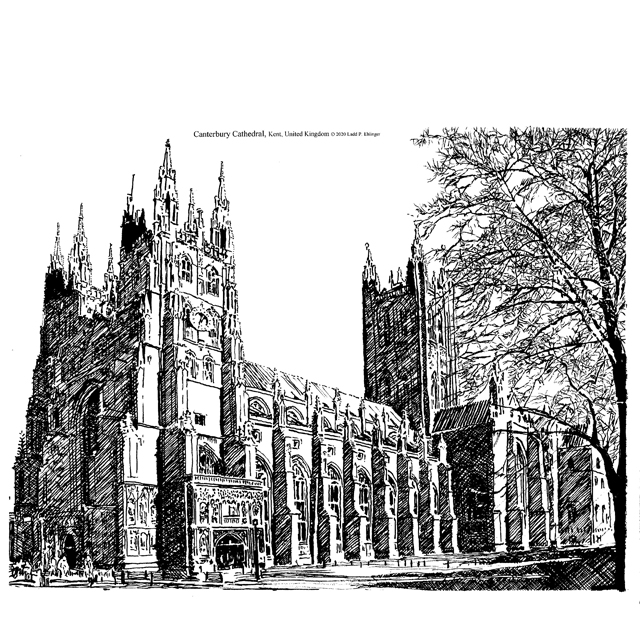
Projects Newsletters Personnel Contact

This issue's limited edition print of a sketch by Ladd P. Ehlinger, AIA is of Canterbury Cathedral in Canterbury, Kent, United Kingdom. The cathedral was originally founded in 597, rebuilt between 1070 and 1077 by the Normans, and greatly altered and enlarged in the 12th century in the Gothic style in response to a fire. The east end, where the Quire (Choir) is, was extensively altered in 1175-1184 to accommodate pilgrims visiting the shrine of Thomas Becket, the Archbishop of Canterbury, who was murdered in the cathedral in 1070 by four knights of King Henry II in response to Henry's plea: ”Will no one rid me of this turbulent priest?“ Thomas Becket opposed most everything that Henry II wanted to do.
In 1377 the nave (main body of the church) was demolished and rebuilt with cloister vaulting as it is today. In 1538, Becket's shrine was demolished by Henry VIII. In 1660 extensive repairs were made after Puritan damage to the entire complex - horses were actually stabled in the Nave. In 1834 the northwest tower was rebuilt, and in 1954 the Library was rebuilt repairing WWII damage.
The Master Mason who did most of the rebuilding of the Quire in 1175-1179 was a Frenchman, William of Sens, who was relieved after an injury from a fall from the scaffolding. He was replaced by one of his assistants, known as ”William the Englishman.“
The Archbishop of Canterbury is the head of the Anglican Episcopal Church. St. Augustine first arrived in 597 to found the cathedral. He dedicated it to Jesus Christ, the Holy Savior. The cathedral was part of a Benedictine monastic community known as Christ Church, Canterbury, which lasted until Henry VIII.
There were actually a total of five Archbishops of Canterbury that have been murdered. The first was the Archbishop Aelfheah who was taken hostage by Danes in raids in 1011, and subsequently killed in Greenwich in April 1012. The second was Thomas Becket in 1170. The third was Simon Sudbury in 1381 by beheading.The fourth was Thomas Crammer, who was convicted of heresy and put to death by burning in 1555. The fifth and final was William Laud, who was executed in office for unknown reasons in 1645. Because the Archbishop of Canterbury is the head of the Anglican Episcopal Church of England, he is naturally the center of attention of the media and the public, and especially so when the Archbishop takes controversial positions politically such as advocating Communism as some recent Archbishops have done. Thankfully, the Queen does not use assassination as a means of political and religious control as her predecessors did.
Ladd P. Ehlinger, AIA